News
News Release
Japanese joint research group achieves a world record of 1.2Tbps for optical signal transmission with over 1Tbps data transfer in field trial
Transmission over distance of 336 km at 1.2 Tbps per optical wavelength and data transmission at over 1 Tbps between general-purpose server contributes to the realization of high-speed and high-capacity academic communication networks essential for the promotion of advanced scientific and technological research
Tokyo, October 30, 2023 - A Japanese consortium of joint research partners including the National Institute of Informatics (NII), Nippon Telegraph and Telephone Corporation (NTT), Nippon Telegraph and Telephone East Corporation (NTT EAST), and Fujitsu Limited today announced that they have constructed the world's longest transmission link at 1.2 Tbps per optical wavelength and succeeded in full throughput transmission and the world's largest capacity data transfer over 1 Tbps using a pair of general-purpose 1-socket servers on October 17, 2023.
This field trial was conducted using NTT EAST's commercial optical fiber, NTT's digital signal processing technology and devices, Fujitsu's next-generation optical transmission system 1FINITY Ultra Optical System, and Massively Multi-Connection File Transfer Protocol (MMCFTP*1), a file transfer protocol developed by NII.
This achievement opens the door to a variety of high-speed, high-capacity communication services, including academic communication networks, while simultaneously contributing to lower costs and lower power consumption. The research group will use this achievement to further advance academic communication networks and promote research and development toward the realization of the Innovative Optical and Wireless Network (IOWN*2).
Background
In recent years, communication traffic has increased rapidly due to the development of 5G services, big data, AI, cloud computing, etc., and there is a need to further increase the speed and capacity of communication networks.
Since April 2022, for example, NII has been operating SINET6*3, an academic information network connecting all prefectures in Japan with 400 Gbps lines excluding Okinawa connecting with 200G. SINET6 also connects Japan and the United States with 200 Gbps lines. However, demand for SINET6 has been rapidly increasing, for example, transferring data is approaching 400 Gbps, and as access lines for universities and research institutions have become faster (currently 15 lines of 400 Gbps, 88 lines of 100 Gbps, 884 lines of 10 Gbps, etc.). Thus, further capacity expansion is desired to reach over 400 Gbps.
At the same time, NTT aims to realize the All-Photonics Network (APN) under the IOWN initiative by around 2030. NTT also aims to increase the transmission capacity by 125 times by introducing photonics-based technology at APN to realize overwhelmingly low power consumption, high quality, high capacity, and low delay transmission that is difficult with current electronics-based technology.
To achieve these goals, NII is working on high-throughput file transfer technology that maximizes the use of high-capacity circuits. Fujitsu and NTT are also developing digital coherent signal processing circuits and photoelectric fusion devices that can deliver the world's largest capacity optical transmission of 1.2 Tbps per optical wavelength, as well as optical transmission systems.
In this field trial, the research group combined the technological development results of each organization and demonstrated the world's longest transmission at 1.2 Tbps per optical wavelength and the data transfer.
Field Trials Overview
In October 2023, the research group constructed an optical transmission network environment capable of transmitting 1.2 Tbps per optical wavelength between Tokyo and Kanagawa Prefecture in Japan and conducted 2 types of field trials.
Field Trial 1
The research group constructed a network that starts in Chiyoda-ku, Tokyo and an optical fiber turns around in Yokohama, Kanagawa Prefecture, and confirmed that transmission of 1.2 Tbps per optical wavelength is possible (Figure 1). The full throughput of the 1.2 Tbps signal was verified by a tester for the trial. This is the first time in the world that an optical signal of 1.2 Tbps per optical wavelength has been transmitted over 336 km using commercial optical fiber. The role of each organization in this trial is as follows:
NTT: developed the world's most advanced digital signal processing technology, a chip that implements OTUCn technology*4 capable of multiplexing up to 3 Gigabit Ethernet (400 GbE) chips, and one of the world's largest optical devices with an optical-electrical response band (Figure 2).
Fujitsu: developed a transponder*5 that can achieve a transmission rate of 1.2 Tbps per optical wavelength at 150 Gbaud using a chip developed with Fujitsu and others, led by NTT.
NTT EAST: developed a trial optical network using commercial optical fiber.
Field Trial 2
The research group transferred data using MMCFTP using NII's a pair of general-purpose 1-socket servers in an environment that transmits 1.2 Tbps (Figure 3). As a result of the trial, a large capacity data of about 47 TBytes was successfully transferred at a data transfer rate of 1,034 Gbps. At a data transfer rate of 1034 Gbps, one Blu-ray disk with a typical capacity of 25 GBytes can be transferred in about 0.2 seconds. 47 TBytes of data is roughly equivalent to that contained in 1,880 Blu-ray discs can be transferred in approximately 376 seconds.
Future Plans
NII is supporting the development of Japanese research and education nationwide through the development of SINET, the world's highest-performance network infrastructure, and will continue to pursue its advantages of both ultra-high speed, high capacity, and low latency. In addition, NII will also provide MMCFTP widely to SINET users to realize efficient data distribution and enhance practicality.
NTT aims to further advance the IOWN APN, which enables overwhelmingly low power consumption, high capacity, and low delay transmission, by developing a large-capacity optical transmission system utilizing these results.
NTT EAST will continue to study the realization of high-speed and large-capacity communication services using large-capacity optical transmission systems.
Fujitsu will continue to develop technologies to increase the capacity and reduce the power consumption of optical transmission systems based on the results of this demonstration and contribute to the realization of a sustainable society together with its customers and partners.
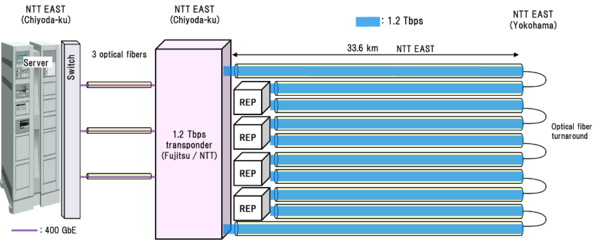
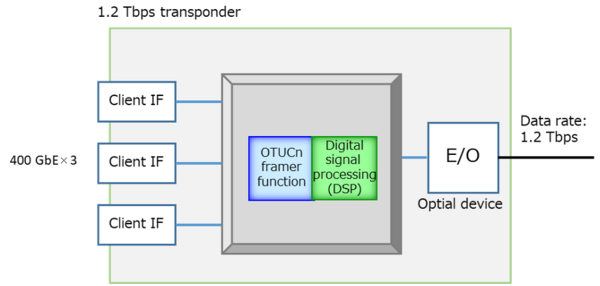
About NTT
NTT contributes to a sustainable society through the power of innovation. We are a leading global technology company providing services to consumers and business as a mobile operator, infrastructure, networks, applications, and consulting provider. Our offerings include digital business consulting, managed application services, workplace and cloud solutions, data center and edge computing, all supported by our deep global industry expertise. We are over $95B in revenue and 330,000 employees, with $3.6B in annual R&D investments. Our operations span across 80+ countries and regions, allowing us to serve clients in over 190 of them. We serve over 75% of Fortune Global 100 companies, thousands of other enterprise and government clients and millions of consumers.
About NTT EAST
NTT East's commitment to telecommunication services began approximately 150 years ago, when we initiated efforts to propagate the use of telephones. Our mission has been steadfast to connect people and to foster understanding through expanding the area of telecommunication services and stabilizing the services.
Today, Japan boasts an optical fiber network coverage rate exceeding 99%, providing comprehensive communications infrastructure. As we gaze into the future, our focus is shifting towards fostering a sustainable, circular society. Our dedication to value creation through our nationwide communications infrastructure aims at enriching society and local communities. In close collaboration with these communities, we strive to create value. This value is then disseminated broadly using digital technology and information and communication technology (ICT). By carrying out these endeavors, we are committed to becoming a partner in shaping a future society that emphasizes diversity and sustainability.
About Fujitsu
Fujitsu's purpose is to make the world more sustainable by building trust in society through innovation. As the digital transformation partner of choice for customers in over 100 countries, our 124,000 employees work to resolve some of the greatest challenges facing humanity. Our range of services and solutions draw on five key technologies: Computing, Networks, AI, Data & Security, and Converging Technologies, which we bring together to deliver sustainability transformation. Fujitsu Limited (TSE:6702) reported consolidated revenues of 3.7 trillion yen (US$28 billion) for the fiscal year ended March 31, 2023 and remains the top digital services company in Japan by market share.
Find out more: www.fujitsu.com
Related Link
- Science Information NETwork SINET6
https://www.sinet.ad.jp/en
News Release: PDF
- (*1) MMCFTP:A file transfer protocol that uses a large number of TCP connections at the same time when transferring big data. It dynamically adjusts the number of TCP connections according to network conditions such as the amount of delay and packet loss rate, thereby achieving stable and ultra-fast data transfer. It supports multipath transfer (transfer of a single data (file) using multiple paths simultaneously), and simultaneous transfers were made in 12 paths in this trial.
- (*2) IOWN:The IOWN (Innovative Optical and Wireless Network) is an initiative for networks and information processing infrastructure including terminals that can provide high-speed, high-capacity communication utilizing innovative technology focused on optics, as well as tremendous computational resources. This is done in order to overcome the limitations of existing infrastructure with innovative technologies, optimize the individual with the whole based on all available information, and create a rich society that is tolerant of diversity.
https://www.rd.ntt/e/iown/ - (*3) SINET6:A network dedicated to academia for the joint use of large research facilities, strengthening cooperation in each field of research, international cooperation with countries around the world, dissemination of academic information and sharing of big data, quality improvement of university education, regional revitalization, establishment of knowledge-based bases for regional universities, and industry-university cooperation. Nodes (network connection points) are set up in all prefectures and connected via 400 Gbps lines (excluding Okinawa connecting with 200G) to provide services to more than 1,000 universities, research institutes, etc.
- (*4) OTUCn technology:A technology that accommodates services over 100 Gbps (such as ultra-high-speed Ethernet signals) and transmits data reliably over an optical network.
- (*5) Transponder : A device capable of transmitting and receiving optical signals.

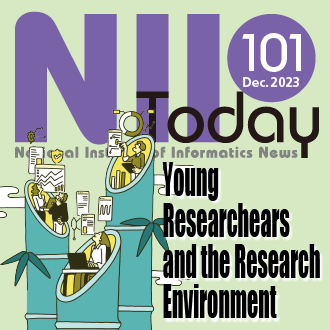 NII Today No.101(EN)
NII Today No.101(EN) SINETStream Use Case: Mobile Animal Laboratory [Bio-Innovation Research Center, Tokushima Univ.]
SINETStream Use Case: Mobile Animal Laboratory [Bio-Innovation Research Center, Tokushima Univ.]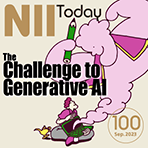 NII Today No.100(EN)
NII Today No.100(EN)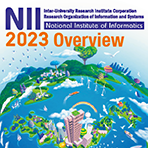 Overview of NII 2023
Overview of NII 2023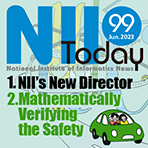 NII Today No.99(EN)
NII Today No.99(EN) Guidance of Informatics Program, SOKENDAI 23-24
Guidance of Informatics Program, SOKENDAI 23-24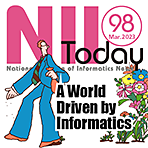 NII Today No.98(EN)
NII Today No.98(EN) The National Institute of Information Basic Principles of Respect for LGBTQ
The National Institute of Information Basic Principles of Respect for LGBTQ DAAD
DAAD
